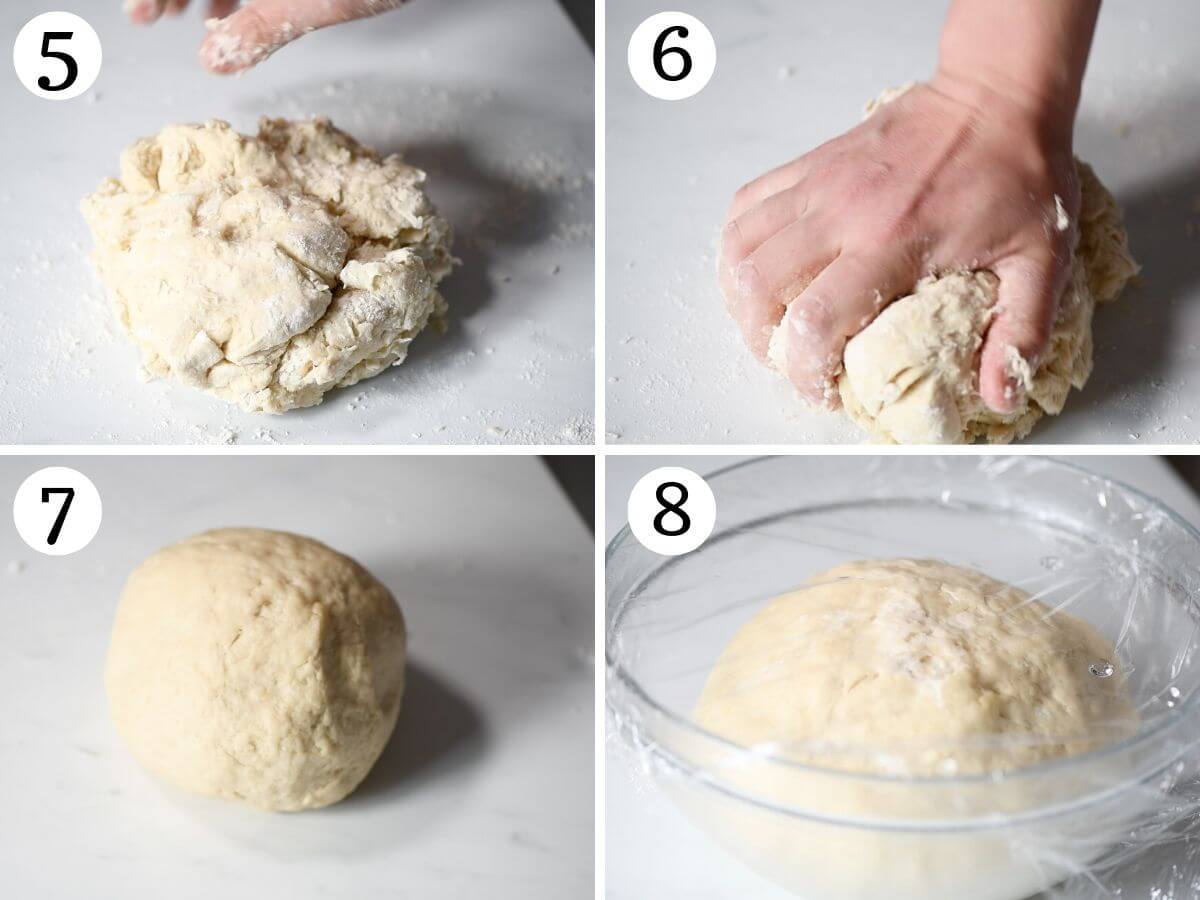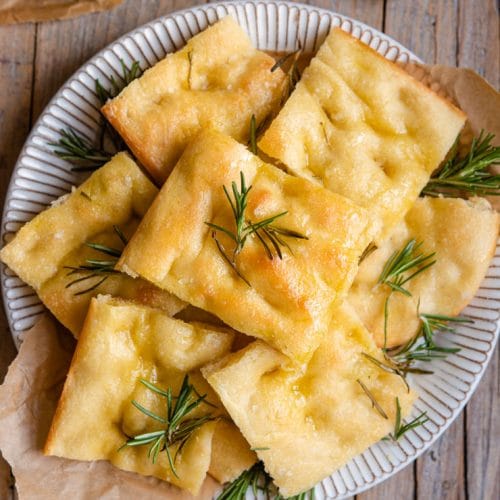Gnocco Fritto (also known as Crescentine) is an incredibly delicious Italian snack from the Emilia-Romagna region. Crispy pillows of savoury fried dough served warm with cured meats and cheese!

Gnocco Fritto is one of the many delights from the Emilia-Romagna region in Italy, home to Parmigiano Reggiano cheese, Parma ham, Mortadella and famous dishes such as Ragu alla Bolognese and Tortellini in Brodo!
If you've never tried Gnocco Fritto let me warn you, they're addictive! Salty and crispy fried dough served warm with cured meats and cheese, does it get much better?
Traditionally they're served on special occasions, Sunday lunch or public festivals. I've often had them served as an aperitivo with drinks too which I love.
See the recipe below including notes on ingredients, step by step photos, tips, variations and a video tutorial. For the full printable recipe scroll to the bottom or click the recipe link below
Jump to:
Ingredients

Ingredient notes and substitutions
- Italian 00 flour - you can also use bread flour or all-purpose flour
- Lard - if you don't want to use lard you can replace it with unsalted butter
- Whole milk - warmed slightly to help with the proving of dough.
- Yeast - I use fast-action (instant) yeast that doesn't need to be activated first but make sure to read your packet instructions in case yours does.
- Sugar and salt - it's important to add these at different times. If you add the salt directly into the yeast it can kill it and stop your dough from proving.
- Sunflower oil - traditionally the gnocco fritto are fried in lard but I find sunflower or vegetable oil a lot easier.
Never Miss A Recipe!
Get all the latest recipes and Italian content sent straight to your inbox (plus our top 10 Italian cooking secrets!)
Step by step photos and instructions
Warm the milk in a saucepan then turn off the heat and set aside. Make sure it’s warm and not hot.
Put the flour, yeast and sugar in a large mixing bowl and stir together. Make a well in the centre of the flour and add the warmed milk (please note: check your packet instruction for how to use your yeast. If it needs activating in liquid first, you can add it to the warm milk for 5-10 minutes before starting) (photos 1 & 2).

Use a spoon or spatula to stir everything together until a very rough dough has formed (photo 3).
Add the lard and salt and knead the dough with your hands until the lard is fully incorporated into the dough (photos 4-6).
Put the dough into a clean bowl and cover with plastic wrap (cling film). Let the dough rise at room temperature for 2 hours (photo 8).

Put the sunflower oil in a large frying pan so it’s about 2 inches deep. Heat to 180C using a thermometer.
Meanwhile, lightly sprinkle a clean work surface with flour and roll the dough out until about 3mm thick (photos 9 & 10).

Using a pizza wheel or knife cut the dough into rough squares about 5-6cm wide. Fry the gnocchi in small batches until puffed and golden brown (1-2 minutes each side). Drain on kitchen paper and serve (photos 11 & 12).
How to serve Gnocco Fritto
I love to eat Gnocco Fritto served straight from the pan, hot with a sprinkling of salt and an aperitivo cocktail like an Aperol Spritz.
Traditionally they're served as an antipasto with cured meats such as Prosciutto crudo, Mortadella or Coppa and a soft cheese like Stracchino or Squacquerone washed down with sparkling Lambrusco wine.
Gnocco Fritto are even served as dessert with a spoonful of Nutella on top, delicious!
Recipe tips
- Activating the yeast - the yeast we use does not have to be activated in water first but make sure to check your packet instructions in case yours does. If it does, you can add it to a small amount of the warmed milk.
- Proving the dough - I let my dough rise a room temperature, away from direct sunlight.
- Use a thermometer - I recommend using a thermometer to keep an eye on the temperature of the oil. Fry them in small batches and try not to over-crowd the pan to make sure they cook evenly.
- Use a kitchen scale - as always, I recommend using a kitchen scale when working with flour as measuring cups are so inaccurate and give you different results each time.
Recipe FAQs
The name Gnocco Fritto comes from Modena but it has different names depending on what part of Emilia-Romagna you're in. For example, in Bologna, they're known as Crescentine, in Parma, they're called Torta Fritta and in Chieza they're called Chizza Fritta (just to name a few).
Yes, leftover dough can be stored in the fridge for 1-2 days or can be frozen. Defrost the dough in the fridge then bring it to room temperature before using.

More Italian bread recipes
If you’ve tried this Gnocco Fritto recipe or any other recipe on the blog then don’t forget to rate the recipe and let me know how you got on in the comments below, I love hearing from you! You can also follow us on Facebook, Instagram and Pinterest or sign up to our Newsletter to see more of our delicious food
☆Full Recipe
Gnocco Fritto (Italian Fried Dough)
Ingredients
- 500 g Italian 00 flour (4 cups)
- 1 teaspoon sugar
- 1 teaspoon fast action (instant) yeast
- ½ teaspoon fine salt
- 250 ml whole milk (1 cup plus 1 tablespoon)
- 70 g lard or butter (2.4oz or 5 tablespoons)
- Sunflower oil for frying
For serving
- Prosciutto crudo or other cured meats
- Stracchino or Crescenza cheese
Instructions
- Warm the milk in a saucepan then turn off the heat and set aside. Make sure it’s warm and not hot.
- Put the flour, yeast and sugar in a large mixing bowl and stir together. Make a well in the centre of the flour and add the warm milk (please note: check your packet instruction for how to use your yeast. If it needs activating in liquid first, you can add it to the warm milk for 5-10 minutes before starting).
- Stir everything together until a very rough dough has formed. Add the lard and salt and knead the dough with your hands until the lard is fully incorporated into the dough.
- Put the dough into a clean bowl and cover with plastic wrap (cling film). Let the dough rise at room temperature for 2 hours.
- Put the sunflower oil in a large frying pan so it’s about 2 inches deep. Heat to 180C using a thermometer.
- Meanwhile, lightly sprinkle a clean work surface with flour and roll the dough out until about 3mm thick.
- Using a pizza wheel or knife cut the dough into rough squares about 5-6cm wide. Fry the gnocchi in small batches until puffed and golden brown (1-2 minutes each side). Drain on kitchen paper and serve with cheese and prosciutto.
Notes
-
- Activating the yeast - the yeast we use does not have to be activated in water first but make sure to check your packet instructions in case yours does. If it does, you can add it to a small amount of the warmed milk.
- Proving the dough - I let my dough rise a room temperature, away from direct sunlight.
- Use a thermometer - I recommend using a thermometer to keep an eye on the temperature of the oil. Fry them in small batches and try not to over-crowd the pan to make sure they cook evenly.
- Use a kitchen scale - as always, I recommend using a kitchen scale when working with flour as measuring cups are so inaccurate and give you different results each time.
- Storage - the gnocco fritto are best served immediately but will keep in an air-tight container for 1-2 days. The dough can be stored in the fridge for 1-2 days before frying or can be frozen.
Nutrition
- I always use extra virgin olive oil in all of my recipes unless stated otherwise
- When I use canned or jarred tomatoes of any kind I always use Cirio or Mutti brands for the best results and flavour.
- All vegetables are medium sized unless stated otherwise
- All recipes are tested and developed using a fan (convection) oven
- Find out more about how nutrition is calculated.
- Check out our must have Italian Pantry Staples.
- You can also find all our Essential Kitchen Tools for Italian Cooking.










Leave a Reply